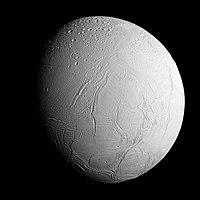
Photo from wikipedia
Planetary Geology Saturn's moon Enceladus has a subsurface ocean covered by a layer of ice. Some liquid escapes into space through cracks in the ice, which is the source of… Click to show full abstract
Planetary Geology Saturn's moon Enceladus has a subsurface ocean covered by a layer of ice. Some liquid escapes into space through cracks in the ice, which is the source of one of Saturn's rings. In October 2015, the Cassini spacecraft flew directly through the plume of escaping material and sampled its chemical composition. Waite et al. found that the plume contains molecular hydrogen, H2, a sign that the water in Enceladus' ocean is reacting with rocks through hydrothermal processes (see the Perspective by Seewald). This drives the ocean out of chemical equilibrium, in a similar way to water around Earth's hydrothermal vents, potentially providing a source of chemical energy. Science , this issue p. [155][1]; see also p. [132][2] [1]: /lookup/doi/10.1126/science.aai8703 [2]: /lookup/doi/10.1126/science.aan0444
Journal Title: Science
Year Published: 2017
Link to full text (if available)
Share on Social Media: Sign Up to like & get
recommendations!